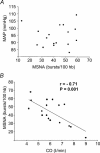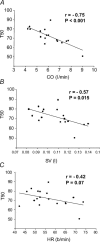Balance between cardiac output and sympathetic nerve activity in resting humans: role in arterial pressure regulation
- PMID: 16037092
- PMCID: PMC1474766
- DOI: 10.1113/jphysiol.2005.090076
Balance between cardiac output and sympathetic nerve activity in resting humans: role in arterial pressure regulation
Abstract
Large, reproducible interindividual differences exist in resting sympathetic nerve activity among normotensive humans with similar arterial pressures, resulting in a lack of correlation between muscle sympathetic nerve activity (MSNA) and arterial pressure among individuals. Although it is known that the arterial pressure is the main short-term determinant of MSNA in humans via the arterial baroreflex, the lack of correlation among individuals suggests that the level of arterial pressure is not the only important input in regulation of MSNA in humans. We studied the relationship between cardiac output (CO) and baroreflex control of sympathetic activity by measuring MSNA (peroneal microneurography), arterial pressure (arterial catheter), CO (acetylene uptake technique) and heart rate (HR; electrocardiogram) in 17 healthy young men during 20 min of supine rest. Across individuals, MSNA did not correlate with mean or diastolic blood pressure (r<0.01 for both), but displayed a significant negative correlation with CO (r=-0.71, P=0.001). To assess whether CO is related to arterial baroreflex control of MSNA, we constructed a baroreflex threshold diagram for each individual by plotting the percentage occurrence of a sympathetic burst against diastolic pressure. The mid-point of the diagram (T50) at which 50% of cardiac cycles are associated with bursts, was inversely related to CO (r=-0.75, P<0.001) and stroke volume (SV) (r=-0.57, P=0.015). We conclude that dynamic inputs from CO and SV are important in regulation of baroreflex control of MSNA in healthy, normotensive humans. This results in a balance between CO and sympathetically mediated vasoconstriction that may contribute importantly to normal regulation of arterial pressure in humans.
Figures





References
-
- Castellano M, Rossi F, Giacche M, Perani C, Rivadossi F, Muiesan ML, Salvetti M, Beschi M, Rizzoni D, Agabiti-Rosei E. Beta2-adrenergic receptor gene polymorphism, age, and cardiovascular phenotypes. Hypertension. 2003;41:361–367. - PubMed
-
- Chapleau MW, Abboud FM. Contrasting effects of static and pulsatile pressure on carotid baroreceptor activity in dogs. Circ Res. 1987;61:648–658. - PubMed
-
- Chapleau MW, Abboud FM. Determinants of sensitization of carotid baroreceptors by pulsatile pressure in dogs. Circ Res. 1989;65:566–577. - PubMed
-
- Charkoudian N, Martin EA, Dinenno FA, Eisenach JH, Dietz NM, Joyner MJ. Influence of increased central venous pressure on baroreflex control of sympathetic activity in humans. Am J Physiol Heart Circ Physiol. 2004;287:H1658–H1662. - PubMed
Publication types
MeSH terms
Grants and funding
LinkOut - more resources
Full Text Sources

